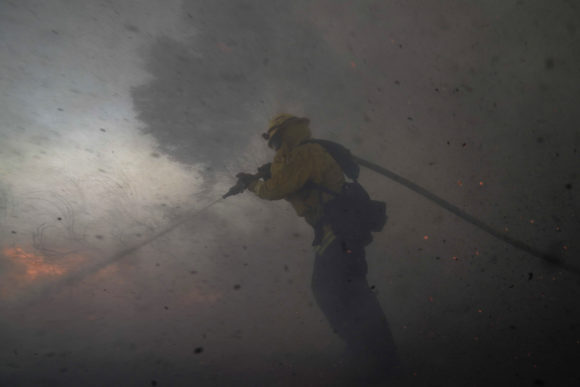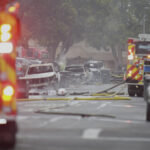SACRAMENTO, Calif. — Two firefighters critically burned while trying to set backfires to slow the spread of a Southern California wildfire in October likely shouldn’t have been there in the first place given the extraordinarily dangerous conditions, according to an investigation of the incident.
It appears, but is not certain from the report by the Orange County Fire Authority, that wind-driven embers spreading from the backfires themselves are what trapped the agency’s firefighters. It says firefighters left themselves in danger from unburned fuels, increasing erratic winds and frequent spot fires.
“Their burnout may have backfired,” said Timothy Ingalsbee, a former federal firefighter who reviewed the report at the request of The Associated Press. “That’s a horrible thought.”
The wind was blowing so hard it kept extinguishing the drip torches the crew was using to ignite fires intended to create a wider buffer against the advancing flames by preemptively burning the available fuel that was feeding the Silverado Fire.
The speed at which the fire could spread under conditions at the time was at “historical levels,” nearly three times as fast as the previous record for that location, and was “the main factor” in the crew becoming trapped by a spot fire that jumped the safety line, according to the report.
”These were explosive fire conditions _ the classic what we call `blowup conditions’ — and the crews were really, really pushing the envelope” by trying to set backfires, said Ingalsbee, executive director of Firefighters United for Safety, Ethics, and Ecology.
The Silverado Fire ignited early Oct. 26 near Irvine, a city of 280,000 about 35 miles (56 kilometers) south of Los Angeles, eventually damaging or destroying 14 homes and structures. That fire and another blaze just to the north at one point forced the evacuation of 130,000 people.
Orange County Fire Authority spokeswoman Colleen Windsor said the wildland firefighters, Dylan Van Iwaarden, 26, and Phi Le, 31, remain in critical condition. She declined to comment or provide more information or clarification beyond what is in the report itself. The state’s firefighting agency referred questions to the local authority.
The crew was trying to fight a spot fire that exploded from the size of a living room rug to a 10,000-square-foot (3,048 square meters) inferno in just five to 10 seconds.
Then the second fire ignited below them.
“Get out of there, there’s a spot!” yelled one of the crew members, according to the report.
But they never had a chance, nor any time to deploy the portable fire shelters designed as a last-chance shield against the flames.
All eight members of the crew trying to contain the fire with hand tools, chain saws and fire hoses were overrun by the flames. Six reported singed hair, eyebrows, and eyelashes, while one firefighter came “staggering out of the fire, critically burned” while the second critically burned firefighter was spotted 30 seconds later at the edge of the blaze.
Graphic photos of their fire-resistant uniforms included in the report show their yellow jackets singed and torn. But while one firefighter’s trousers are torn and discolored, the second set of trousers is burned to the length of a patchwork pair of shorts.
“Human flesh burns well before the ignition point of that fabric, so just from the radiant heat, the convective heat of the hot winds, those crews were cooking well before the flames even reached their clothing,” Ingalsbee said. “I think it’s a minor miracle they were able to stumble out to safety and are alive.”
The area is covered in grass and brush and will quickly grow back, he said. And with no homes in the immediate area, he questioned why crews tried to stop the fire’s advance in an area where it may be beneficial to let it burn.
The Southern California Edison utility reported to state officials that it is investigating whether its equipment might have sparked the blaze.
It told utility regulators that a “lashing wire” that ties a telecommunications line to a supporting cable may have come into contact with a separate 12,000-volt conductor line above it.
The wire may have belonged to T-Mobile, not Edison, the utility said in a recent filing with state utility regulators. But the company is also evaluating other potential causes such as human activity or the construction, maintenance, and design of overhead wires a few hundred feet from where the fire started, spokesman David Song said Wednesday.
–Associated Press writer Christopher Weber contributed to this report from Los Angeles.
About the photo: In this Monday, Oct. 26, 2020 file photo, A firefighter battles the Silverado Fire in Irvine, Calif. (AP Photo/Jae C. Hong, File)
Was this article valuable?
Here are more articles you may enjoy.


 Delivery Hero Hit by $376 Million Fine for Glovo Cartel
Delivery Hero Hit by $376 Million Fine for Glovo Cartel  Plane Crashes into San Diego Neighborhood, Setting Homes And Vehicles on Fire
Plane Crashes into San Diego Neighborhood, Setting Homes And Vehicles on Fire  Hackers Abuse Modified Salesforce App for Data Theft and Extortion, Google Says
Hackers Abuse Modified Salesforce App for Data Theft and Extortion, Google Says  DIY Home Inspections? They Are Taking Over, Firms Say
DIY Home Inspections? They Are Taking Over, Firms Say 